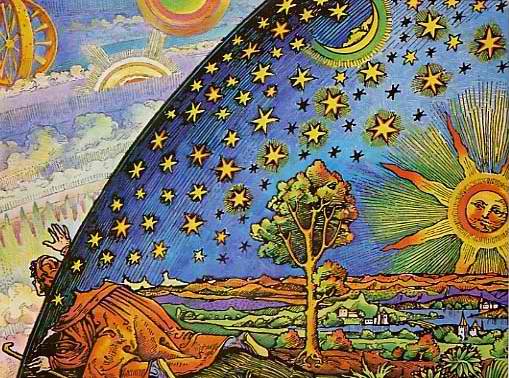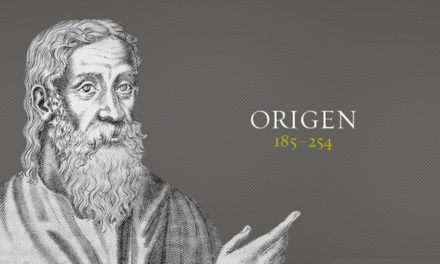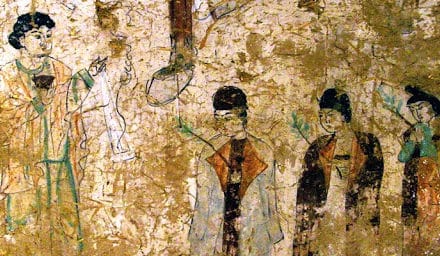For 2nd generation Christians—let’s say, those who came to faith after AD 70, Jesus became less a person they’d personally known, or the friend of a friend—but more of a mysterious agent in a cosmic drama.
Because so many of today’s pseudo-Christian cults deny Jesus’ deity, it comes as a surprise that the earliest of the heresies to trouble the Church had no problem accepting Jesus’ divine status. What they struggled with was accepting His humanity.
But I’m getting ahead of myself. Let’s back up …
The first couple generations of Christians assumed Jesus was returning soon. That expectation may have fueled that amazing sense of community we find in the early chs of the Book of Acts where we read they sold off property and distributed to one another so all needs were met. Many scholar now believe Early Church leaders didn’t bother composing a systematic theology because they assumed Jesus’ return in glory was imminent. When delayed, they saw the need to establish a better system for leading the church & setting down guidelines for future believers. The Teaching of the Twelve Apostles, AKA as the Didache written about a century after Christ, was just such a work.
After a while, Church leaders found they were answering the same questions and dealing with the similar objections over and over again. So individuals began penning replies as stock answers others could refer to.
Sometime around the mid 2nd C, Justin Martyr wrote his First Apology dealing with pagan arguments, then authored Dialog with Trypho the Jew, dealing with Jewish objections.
But it wasn’t until Irenaeus, bishop of Lyons in S Gaul, wrote his master-work Against Heresies at the end of the 2nd C, that a work we might call a systematic theology was first produced. The actual title was The Unmasking and Refutation of Falsely So-Called Gnosis and gives us a hint of what prompted Irenaeus to set pen to parchment è Gnosticism.
The Gnostics put together a coherent body of belief before Christians did. And it might be said that Christian systematic theology was a reaction to the Gnostic challenge. Late to the game, when Christian theologians finally took up the task, they were so thorough in their refutation of Gnosticism, it petered out and fell into the abyss of oblivion. Waiting to be resurrected in modern times by skeptical scholars redacting history and selling books suggesting Gnosticism was the real faith of Jesus and the Apostles; ideas that depend on silence for their support.
As an editorial note, & maybe rant is a better description, and expressing my own opinion only: è Post-modernism regards the historical record with such suspicion, it’s assumed what really happened is in fact the opposite of where the evidence points. Using the rubric that “It’s the winners who write the history,” post-modern scholars eschew the records and assume all history prior to the last 50 yrs is rank propaganda. So whatever the record says, is fabrication. What REALLY happened is the opposite. It’s an argument from silence. But it’s that silence the post-modern assigns the weight of authority.
So if the record of history shows Gnosticism was an aberrant faith dismantled by early Christian theologians, well, the opposite must in fact have been the case. Gnosticism WAS early Christianity, beaten out by political elites who found it too egalitarian for their tastes and desire to remain in control of a poor and uneducated public; blah, blah, blah.
The problem with this skeptical post-modern view of history is not only that it’s an argument from silence—if true, it makes everyone an historical agnostic. We can’t really now ANYTHING prior to the Modern Era because everything is suspect. The post-modern would have us ignore any authority but theirs to tell us what NOT to believe.
Sorry, but I’ll stick with the classics, skewed as they may be. Wed can discern more about what happened by the record of the past than by layering post-modern sensibilities on top of previous generations and saying what OUGHT to have been is what really occurred.
End of rant.
As we saw in Season 1, Gnosticism was a widespread movement that drew impetus from the emerging Christian movement. It was a worldview that merged religion and philosophy and probably ought to have been expected in its time and place.
The Roman Empire stretched its sticky fingers into many regions that had mostly kept to themselves. There’d been trade btwn these areas for centuries, but Rome’s political and economic dominance saw borders drop and peoples of disparate cultures mix on a wide scale for the first time. Rome first imbibed the philosophy and religion of Greece, then this Greco-Roman worldview absorbed Eastern mysticism. The result was Gnosticism; a religious worldview that merged the Greek idea of dualism with the appeal of mysterious secrets that led the adherent to a salvation born of enlightenment.
But Gnosticism stalled when it came in contact with The Gospel because, while Gnostic sages sold their mysteries, Christians offered their stuff for free. And besides, converts to Christianity experience a genuine change that turned them from sinner to saint. In a clever marketing ploy, Gnostics adopted Christian terms & forms, presenting themselves as an advanced form of the Faith.
Most of what we know about Gnosticism, or at least that branch of it that sought to ride on the back of Christianity, is drawn from Irenaeus’s work refuting it; that 5 volume work known as Against Heresies.
While trying to retain several ideas and terms intrinsic to the Faith, Gnostics ejected dependence on Jewish history, a large part of the New Testament, the Biblical Jesus and Apostles. We might ask, “Well, after all that, what’s left?”
Gnostics replaced the Bible’s story of creation with an elaborate mythology of the spiritual realm being populated by a virtually endless hierarchy of spiritual beings they called “aeons.” Salvation was conceived of, not as deliverance from sin, but as enlightenment. That enlightenment came by being initiated into ever deeper levels of knowledge of the aeonic realm. Following Greek dualism, spirit was good while matter was bad. Both unalterably so.
So God, and by that I mean the Original First Cause, was so good, so holy, it could never have created the physical universe. No, something as corrupt as the Earth could only be the product of some far-down the line aeon that was SO distantly removed from the First Cause or the High God, that it was able to create matter; the physical universe.
The goal of the Gnostic was to learn the names of the aeons and their unique special character as far back up the line toward the First Cause as possible. The idea was that the higher aeon you knew, the more aware of the divine you became and the less the corruption of the physical had hold of you.
So Gnostics adored Christians words & phrases like “mediator, logos, the Holy Spirit, being filled with the Spirit, and regeneration.” But they stripped them of their origin in the Historic Gospel and Life of Jesus. What allowed Gnosticism to explode during the first half of the 2nd C was that the NT hadn’t come together as a recognized canon yet.
What made Gnosticism appealing and not just another philosophy for academics to debate was its claim of divine revelation. They loved that Jesus said, “I am the way, the truth, and the life.” They turned Him into one of their aeons. But of course, if He was a divine being, there’s no way He had a physical body. So Gnostics said Jesus was a divine spirit. Some Gnostics called Him angelic. Others said as an aeon He ought to be more properly regarded as a god; a lesser deity somewhere on the hierarchy of aeons reaching back to The First Cause.
But Gnostics categorically rejected the idea Jesus was human. In their system, something so holy would never have a physical body. So the appearance of Jesus was just that, an appearance, a phantom. He left no footprints, cast no shadow, didn’t eat.
Now, those of you who’ve read Matthew, Mark, Luke and John in the NT know these records of Jesus’ life have abundant stories of Jesus physicality. That’s why the Gnostics rejected so much of the NT.
As an aside, if you have a modern translation of the NT, you may note there are occasional footnotes that say something to the effect of, “This verse or this passage not found in the oldest and most reliable manuscripts.” That statement that they’re more reliable is an editorial comment on the part of the publisher. They’re indeed older, but reliable is a debate. The manuscripts they refer to are from the Alexandrian textual tradition, which some conservative scholars believe bear a Gnostic influence and editing. So most of the questioned verses deal with, can you guess? Right: Passages that speak of Jesus’ physicality, such as when He stooped and wrote in the sand.
That remark that the Alexandrian text is “more reliable” isn’t due solely to the fact the manuscripts are older. It’s also an assumption made by more liberal scholars that the shorter text must be more true to the original. Their presupposition is that over time, as manuscripts are hand-copied, those who pen them will be inclined to add material rather than delete it. The discovery of the Dead Sea scrolls nuked that idea. Some of them predated previously extant manuscripts by hundreds of years. Yet the text is virtually identical. It’s nothing but an assumption that the shorter text is more accurate. So if you read that in a footnote, remember it’s not a statement of fact. It’s merely an opinion, one that in all likelihood is based on an erroneous presupposition.
It’s long been believed that Simon Magus, referred to in Acts 8, started the Christianesque-flavored Gnosticism. Simon offered the Apostle Peter money if he’d “teach” him how to bestow the Holy Spirit on others. Peter rebuked Simon’s crass merchandising of the Faith, and it’s from Simon’s offer we get the term “simony” = the practice of purchasing religious office.
Okay, get this: According to the Gnosticm tale, Simon met a woman named Helena at a brothel in the City of Tyre. What he was doing in a brothel, we can only guess, but our guesses need be few; one actually. He wasn’t there to tune their piano. Simon said this Helena was a reincarnation of someone called Ennoia, a manifestation of the Spirit of God. In her previous identity as Ennoia, she’d created many ranks of angels, some of which rebelled against God. These rebels then captured and imprisoned her in a mortal body. She was then reincarnated many times, including one stint as Helen of Troy. But in Simon’s day, she was a prostitute in Tyre. And Simon, of course, was now the highest God’s manifestation come to rescue her.
Simon said the OT was the product of the malicious angels seeking to defame God. To follow Simon was to free oneself from the OT’s oppressive religious requirements.
Christians accused Simon and his devotees of practicing magic and the occult. This became a regular charge by Christians against the Gnostics; that they performed lying signs & wonders. How much of this was mere illusion; remember, Simon began as a magician, an illusionist; and how much of it was the working of demonic power is anyone’s guess. There was likely a bit of both.
Simon’s brand of Gnosticism included several points that will be repeated by later heretical groups.
- There was a blending of Biblical ideas with paganism and Eastern mysticism.
- There was a dualistic view of reality divided into the sacred spirit and profane physical.
- The idea that a Savior had appeared to lead people into salvation.
- A rejection of Jewish Scripture.
- An intense interest in the hidden & secret because it was believed that’s where the good stuff that led to salvation lay. Those secrets were the domain of special teachers who’d impart their goodies upon payment.
Simon Magus reached Rome before people there were familiar with The Gospel. So he was able to present himself as a Savior and gained a significant following. Later Gnostic teachers had to work against a background of greater familiarity with The Gospel and left off claiming to be saviors themselves. They simply worked Jesus into their system as one of the Gnostic Aeons Who’d appeared to help enlighten humanity. And when I say “appeared” I mean that literally. The Gnostics said Jesus was a phantom; that He possessed no physical body but only SEEMED to do so, giving rise to a movement called “Seemism” = Literally Docetism. Even Simon said that as a manifestation of the Highest God, he only appeared to people but had no real body. He only seemed to have flesh.
So, the crucifixion was a farce to Gnostics. Someone as lofty as one of their aeons would never consent to such a travesty! Some of them denied the cross ever happened. Other said that indeed a man did die on a cross outside the walls of Jerusalem, but it wasn’t The Christ; it was just a man named Jesus. They split the divine spirit called Christ & the human man named Jesus into two distinct entities. The Christ-Spirit supposedly descended upon a suitably prepared man named Jesus at his baptism by John. It was that Christ-Spirit that then said & did the stuff we read about in the Gospels. But in the Garden of Gethsemane on the night before His crucifixion, the Christ-Spirit lifted off the man Jesus, so that the person the temple police arrested was a used & bereft shell. What hung on the cross was just a spent flesh-case. Jesus’ death did nothing for the Gnostic. It couldn’t, because Gnostic salvation had nothing to do with sin.
Humanity’s great problem, said the Gnostic, wasn’t sin and its resultant separation from God. Mankind’s problem was ignorance. For Christians, salvation meant deliverance from the penalty, power and ultimately, the presence of sin. The Gnostic aspired to knowledge that would help him / her realize their real identity and existence as primarily a spiritual being over whom the physical realm had no influence.
Gnostics tended to pursue this awareness in one of two ways. Some went the route of extreme asceticism, denying their bodies any and all pleasure. The idea was to abstain from all sensual pleasure, so as to give the spirit complete dominance over their will. But the intense hunger and thirst of severe abstinence has a tendency to have the opposite of the desired effect; it makes you KEENLY aware of the reality and presence of the body.
So while some pursued enlightenment via extreme asceticism, the far more popular route was the exact opposite; a hedonistic immersion in pleasure. An enthusiastic embrace of immorality. These Gnostics said that the way to enlightenment was to engage in scandalous debauchery, then while in the very center of it, to realize that all that was only happening to the body, which is unalterably corrupt anyway, yet their spirit remained pure and untouched by such corruption. It was having your religious & philosophical cake and eating it too. But not just eating it; you were smearing it all over your face, rubbing it into your hair. Taking off you clothes and rolling across a field of 4” layer cakes with cream cheese frosting. All the while saying, “The real me isn’t covered in cake. I’m clothed in the glorious light of Heaven. What’s covered in cake is just the dirt-suit I’ve borrowed in this round of reincarnation.”
As previous said, Irenaeus wrote Against Heresies to refute Gnosticism btwn AD 180-89. But some scholars believe it was already waning as Christians became more conversant in what The Gospel really taught. Gnosticism was able to emerge and secure adherents in its early phase both because of the lack of a NT canon & a widely endorsed Creed. But all that changed during the 2nd C, when more and more books began to be accepted among the churches as normative for the Faith and the earliest versions of what much later was called the Apostles’ Creed settled in.
The history of Gnosticism is a tangled mess of names and conflicting ideas and tenets. It had its own denominations, movements, groups and factions who argued & fought with each other. And while it made a run at Christianity during the early 2nd C that seemed at times to present a real challenge, it ended up proving the truth of something Jesus said to His disciples; that the gates of hell would not prevail against His Church.
While Gnosticism became little more than a dead faith, a field for academics & historians to autopsy, renewed interest in it has flared up whenever the same factors that marked the late 1st C church have been repeated. When the veracity of Scripture is regarded as suspect. When the NT is subjected to the scoffing of critics and the OT is relegated to myth. Gnosticism has managed to flare back to a brief moment of interest when Christianity is cut loose of its historical moorings in real events and made into little more than a moral philosophy. When salvation is deemed a matter of deliverance from ignorance, rather than a return to innocence.






Good work Lance.
Thanks JD
Is it safe to say that the “new age” movement has its roots in Gnosticism? If so, could you elaborate on that?
Brian,
Before I attempt a reply, be aware this is my opinion only.
Basically, Yeah, I’d say that New Age spirituality is in many ways a modernized version of Gnosticism.
But we need to exercise caution because the New Age Movement is a Big Ten sort of deal that’s a hodge-podge / mish-mash of a lot of different alternative spiritualities.
But then, so was ancient Gnosticism. It was a blending of Greek philosophy & Eastern mysticism that adopted Christian terminology (because it was growing in popularity among commoners).
There were some similarities in terms of it’s cosmology and in the ways it’s leaders pass on knowledge.
Scientology is also a modern version of Gnosticism – an eeriy recapitulation of it.
Hi Lance,
I usually enjoy listening to your podcast but I have at times been disappointed with the lack of accuracy. Obviously it is to be expected that every history podcaster will make a few mistakes. However, a lot of other people, (like Mike Duncan for example) correct themselves when they are wrong. I’m not exactly sure why you haven’t, perhaps your listeners haven’t bothered to correct you or maybe you don’t consider it important enough.
So what mistakes am I talking about? In this episode you said that most of the verses that the modern translations omit have to do with the humanity of Christ. This is patently false: you can check wikipedia’s “list of major textual variants to see for yourself. Other mistakes include saying that all the Christians before Augustine believed in the millennium, and, saying they believed in a figurative presence of Christ in the Eucharist instead of literal.
I just thought I would let you know. I would have told you earlier but I’ve been just listening to all your old episodes and just recently caught up to your current ones.
Phillip,
Thanks for pointing out these issues.
When challenged (and that is inordinately rare; wish those who hear an inaccuracy WOULD indeed speak up) I appreciate it. This is the first anyone’s said of these issues. I thank you for identifying your concerns. Please note I’ve “approved” your comment so it’s public.
If I may respond . . .
Regarding omitted verses. You are correct, I misspoke. What I ought to have said was that a preponderance of omitted texts in some way treat with a connection between the spiritual and physical; not all, but a large number of them. In the re-record, I’ll make that more clear.
Regarding the other two issues, please suggest some sources that “give the lie” to pre-millennialism being the orthodox eschatology and a real-literal Presence in the elements among the Ante-Nicaean Fathers. While there were varying eschatological and Eucharistic ideas in that era, it’s my understanding that the accepted orthodox view was as I stated.
Phillip, when I say in an episode that “it was believed // all believed” I’m speaking in the way of usual speech; not the technical and scholarly speech that requires numerous ‘caveats & clarifications. At any given time, there are those who don’t go along with an accepted body of thought. But when those who don’t adopt a position are so few in number and don’t themselves provide a comprehensive alternative to that majority position, it goes well beyond the scope of what CS aims at to mention.
The subjects of Chilliasm and Transubstantiation do indeed become subjects of much discussion and controversy later – for sure! But in the Ante-Nicaean era, isn’t it pretty clear that they position of the Fathers was pre-dominantly pre-millennial and memorial?
Thanks for your response. On the issues of Eucharist and premillenialism, yes it seems that millenialism may have been the majority view although there certainly we’re those such as Dionysus and Origen that thought differently. I can’t agree though that anyone held a memorial view, read Justin Martyr and Ignatius. This was also a hard pill for me to swallow since I’m Anabaptist.
I’ll take up your challenge to investigate the Eucharistic take of Ignatius and & J. Martyr. Will also seek specific references on the issue from other Ante-Nicaean fathers and the memorial view, since you said you can’t find ANY.
Enjoying this episode! I hadn’t ever heard of the “Alexandrian” text problems, and I’m interested. I tried googling for more info, but it was hard to discern what sites would be more reliable vs those that are more…alarmist.
Would you mind tossing me a couple of reputable resources? Thanks!